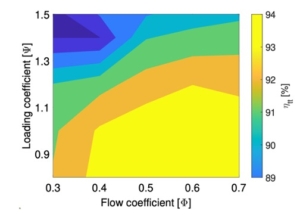Paper on axial turbine flowpath design presented by City, University of London at ASME Turbo Expo, Boston (USA)

Turbine flowpath for a 100 MWe SCARABEUS plant running on mixtures of Carbon Dioxide and Hexafluorobenzene
The researchers at City, University of London have presented their work on the design of the flowpath of large axial turbines for integration into supercritical power cycles operating with Carbon Dioxide mixtures. This research is framed in Work Package 3 – Turbomachinery Design of the project.
The composition of the working fluid has a strong influence on turbine design, as a consequence of two effects. The first one is the impact of working fluid composition on the operating conditions of the cycle that attain peak thermal efficiency. The second one is the impact on the characteristics of the working fluid that are relevant to turbine design. Meanline design codes and CFD tools are combined to assess these effects and to produce optimum flowpath designs.

Impact of loading and flow coefficient on total-to-total efficiency of the turbine
The paper can be downloaded free of charge from the conference website (link). Check the abstract below:
Supercritical CO2 (sCO2) mixtures have been found to be promising for enhancing the performance of power cycles for concentrated solar power (CSP) applications, with up to a 6% enhancement in cycle efficiency compared to a simple recuperated CO2 cycle depending upon the mixture and cycle configuration chosen. Given that turbine efficiency significantly affects the overall plant performance, it is important to confirm whether turbines operating with CO2 mixtures can achieve the same efficiencies compared to pure CO2, whilst exploring whether the use of mixtures introduces any differences in the turbine design. This study aims to investigate the differences in turbine flow path designs produced for pure CO2 compared to CO2 mixtures, whilst taking into account aerodynamic, rotordynamic and mechanical design aspects, as assessed during the mean-line design process. The aim of this study extends to evaluating the effect of key turbine design variables, such as the loading coefficient, flow coefficient and degree of reaction, on the flow path design and overall aerodynamic performance. Multiple flow path designs have been produced for axial turbines operating with pure CO2 and mixtures of CO2 with titanium tetrachloride (TiCL4), hexafluorobenzene (C6F6) and sulphur dioxide (SO2) for installation in a 100 MWe CSP plant. It is found that turbines operating with either pure CO2 or CO2 mixtures result in overall total-to-total efficiencies in excess of 92.5%; where the highest turbine efficiency is achieved for the turbine operating with pure CO2, whilst this reduces by a maximum of 1.1 percentage points for the CO2/TiCL4 mixture. This reduction in efficiency is because the CO2/TiCL4 turbine is limited to a maximum of six design stages in order to meet the imposed mechanical design criteria, whilst the pure CO2 turbine can accommodate thirteen stages leading to higher aerodynamic efficiency. The difference between the two cases is the result of a higher mass-flow rate for the CO2/TiCL4 mixture (66% greater than for pure CO2), which results in high rotor bending stresses and limits the number of stages to comply with the design criteria. It is also found that designing the turbine at loading and flow coefficients of 0.8 and 0.6 respectively, whilst fixing the degree of reaction and pitch-to-chord ratio to values of 0.5 and 0.85 respectively, resulted in an efficiency enhancement of 0.2% with respect to a baseline design produced at loading and flow coefficients of 1.0 and 0.5. This increase is due to being able to increase the number of stages from eleven to fifteen. This indicates that there is not much benefit in modifying key design parameters to improve the turbine efficiency as the 0.2% efficiency enhancement is considered within the margin of accuracy of mean-line flow path design.





